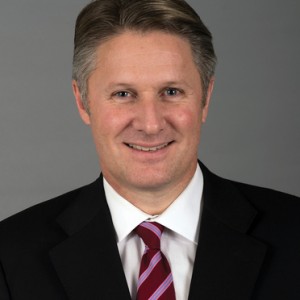'A sharper environment' - is HSF's corporate culture shift behind the recent run of partner exits?
HSF chief Mark Rigotti addresses the firm's recent run of partner departures
February 01, 2017 at 05:42 AM
7 minute read
Four years on from the Anglo-Australian tie-up that created it, Herbert Smith Freehills (HSF) had looked to be having a relatively easy ride.
Recent financial results have been solid, with revenues rising to £870m during 2015-16 against profit per equity partner of £840,000. This has come alongside international expansion into markets such as Duesseldorf and Johannesburg, and impressive mandates including advising on British American Tobacco's $47bn merger with US rival Reynolds and Telefonica's initial public offering plans.
However, between March 2016 and the end of December, more than 20 partners left the firm across London and Asia-Pacific – with many opting to join higher paying US rivals, such as London global energy co-head John Balsdon, who quit for Latham & Watkins in December.
So is the spate of exits anything more than bad luck?
Balsdon's departure took the number of partners leaving HSF for a rival to 22 in nine months (see full list below). At Latham he will be reunited with corporate partner Simon Tysoe, who left in 2015 to co-lead Latham's oil and gas sector group.
Other high profile exits last year included advocacy head Ian Gatt QC to Stewarts Law, London finance partner Nick Bradbury to Allen & Overy, and banking heavyweight Malcolm Hitching to Ropes & Gray.
At Herbert Smith that just never happened. It would have been like setting the Bible on fire
Meanwhile, in the Asia-Pacific region, a team of 10 partners led by Asia finance head Brendan Quinn left to launch an Australia practice for White & Case.
As one London partner concedes: "There have been more departures in the last 12 months than a normal rate."
According to some sources, one potential reason for the exits is that the leadership team has been more actively managing the modified lockstep put in place after the 2012 merger. The emphasis has been on moving people down rather than asking people to leave, but even so, this shift in approach is understood to have unsettled partners, particularly when combined with the impact of the discretionary partner bonus also introduced post-merger.
One former partner comments: "At Herbert Smith that just never happened. It would have been like setting the Bible on fire…unless you found a partner dead in the office, it was pretty impossible to get moved. It was a social contract and that has been broken."
Mark Rigotti, who will become the firm's sole CEO this May after jointly leading the firm alongside Sonya Leydecker for three years, does not deny or apologise for this shift. "I don't buy the thesis that changes at the firm or in the compensation system are driving the departures. I think there are three types of partners who leave: those who are naturally retiring; those who are asked to go for a variety of reasons; and those we'd prefer to keep.
"There is more management of the lockstep. I want to preserve as much as possible of the firm in terms of culture but at the same time make the business efficient, and that does mean a closer view on performance. Part of that means looking at individual compensation, and part is helping the partners with pricing."
Very few of the exits have been among those affected by compensation changes. Rather, former partners suggest the compensation changes reflect a wider move away from a more traditional partnership model to a more corporate approach, which has upset some.
One partner comments: "All of the people leaving were very much part of the legacy Herbert Smith culture. That culture involved proper meetings with proper discussions, where you would be consulted on the firm's plans. That does not happen anymore. It is transforming into a corporate model rather than a proper partnership. Following the merger, it has moved into this much larger firm-style of approach."
Another current partner adds: "A change in direction or strategy is often when people change their mind."
 Rigotti (pictured) acknowledges that the change in direction had not gone down well with some partners but dismisses the idea there is an endemic problem, and notes that 15 lateral hires have joined the firm during the same period.
Rigotti (pictured) acknowledges that the change in direction had not gone down well with some partners but dismisses the idea there is an endemic problem, and notes that 15 lateral hires have joined the firm during the same period.
He argues: "There will always be differences of opinion, and people 'fall out of love' sometimes – that's the world we live in. I'm comfortable people are leaving for a variety of reasons and are not all in that category of difference of opinion. I don't think it's true to say that because the firm is going to be run more like a business rather than a traditional partnership is the one reason people will leave."
He maintains that despite a number of partners voting with their feet against the strategy, the intention is very much to retain a balance between being a large global corporate and a collegiate partnership.
"There is a sweetspot to aim for in between being really corporate-like and being really partnership-like. Corporates are efficient and maximise outputs, but can be rule-based and leave individuals feeling remote. On the other hand, partnerships can be very collegiate but a bit anarchic with lots of inefficiencies.
"A firm's style can swing either way, and my vision is retaining the best of both. [This means] a partnership that makes partners genuinely feel like engaged business owners who are accountable for and involved in the business but, at the same time, running things in ways sensible for a business of our scale so as to achieve sensible efficiencies."
One of those backing this aim comments: "There has always been an ambition within the firm to be better – a self-improvement idea. That has delivered and we are now more business-like as an institution. There's a keener edge to things and a bit of a sharper environment."
The question is whether HSF will be able to achieve its global elite goal if more of its high profile partners head towards the exit. The issue is likely to be particularly pressing, given Rigotti concedes the current year will be more challenging financially due to post-Brexit market instability and overseas investment costs, which are likely to impact partner drawings.
As Rigotti concludes: "In a high performance world, I don't think movement will ever be over. The world is upside down right now; the sector is changing and that's hard for firms. You need to change – it's just a question of how you try to do it to remain competitive."
Herbert Smith Freehills partner exits to rival firms announced in 2016
March
- TMT global co-head Nick Elverston (Ashurst)
- London TMT partner Amanda Hale (Ashurst)
May
- Dubai finance partner Nadim Khan (Jones Day)
- Paris real estate partner Pierre-Nicolas Sanzey (Stephenson Harwood)
- London head of private equity James MacArthur (Weil Gotshal & Manges)
June
- London construction partner James Bremen (Quinn Emanuel Urquhart & Sullivan)
- London litigation partner Christopher Foster (Holman Fenwick Willan)
July
- Perth employment partner Samantha Maddern (Norton Rose Fulbright)
September
- Asia finance head Brendan Quinn (White & Case)
- Melbourne project partner Josh Sgro (White & Case)
- Melbourne project partner Andrew Clark (White & Case)
- Melbourne project partner Alan Rosengarten (White & Case)
- Melbourne project partner Joanne Draper (White & Case)
- Melbourne project partner Jared Muller (White & Case)
- Melbourne regulatory partner Tim Power (White & Case)
- Sydney projects partner Joel Rennie (White & Case)
- Hong Kong finance partner Fergus Smith (White & Case)
- Singapore projects partner Matthew Osborne (White & Case)
October
- London finance partner Nick Bradbury (Allen & Overy)
- London finance partner Malcolm Hitching (Ropes & Gray)
- Paris disputes head Isabelle Michou (Quinn Emanuel Urquhart & Sullivan)
December
- Global co-head of energy John Balsdon (Latham & Watkins)
This content has been archived. It is available through our partners, LexisNexis® and Bloomberg Law.
To view this content, please continue to their sites.
Not a Lexis Subscriber?
Subscribe Now
Not a Bloomberg Law Subscriber?
Subscribe Now
NOT FOR REPRINT
© 2025 ALM Global, LLC, All Rights Reserved. Request academic re-use from www.copyright.com. All other uses, submit a request to [email protected]. For more information visit Asset & Logo Licensing.
You Might Like
View All
DeepSeek and the AI Revolution: Why One Legal Tech Expert Is Hitting Pause
4 minute read
What Happens When a Lateral Partner's Guaranteed Compensation Ends?

Lawyers React To India’s 2025 Budget, Welcome Investment And Tax Reform

Russia’s Legal Sector Is Changing as Western Sanctions Take Their Toll
5 minute readTrending Stories
- 1Exceptional Growth Becoming the Rule? Demand and Rate Hikes Drove Strong Year for Big Law
- 2Dentons Taps D.C. Capital Markets Attorney for New US Managing Partner
- 3Auto Dealers Ask Court to Pump the Brakes on Scout Motors’ Florida Sales
- 4German Court Orders X to Release Data Amid Election Interference Concerns
- 5Litigation Trends to Watch From Law.com Radar: Suits Strike at DEI Policies, 'Meme Coins' and Infractions in Cannabis Labeling
Who Got The Work
J. Brugh Lower of Gibbons has entered an appearance for industrial equipment supplier Devco Corporation in a pending trademark infringement lawsuit. The suit, accusing the defendant of selling knock-off Graco products, was filed Dec. 18 in New Jersey District Court by Rivkin Radler on behalf of Graco Inc. and Graco Minnesota. The case, assigned to U.S. District Judge Zahid N. Quraishi, is 3:24-cv-11294, Graco Inc. et al v. Devco Corporation.
Who Got The Work
Rebecca Maller-Stein and Kent A. Yalowitz of Arnold & Porter Kaye Scholer have entered their appearances for Hanaco Venture Capital and its executives, Lior Prosor and David Frankel, in a pending securities lawsuit. The action, filed on Dec. 24 in New York Southern District Court by Zell, Aron & Co. on behalf of Goldeneye Advisors, accuses the defendants of negligently and fraudulently managing the plaintiff's $1 million investment. The case, assigned to U.S. District Judge Vernon S. Broderick, is 1:24-cv-09918, Goldeneye Advisors, LLC v. Hanaco Venture Capital, Ltd. et al.
Who Got The Work
Attorneys from A&O Shearman has stepped in as defense counsel for Toronto-Dominion Bank and other defendants in a pending securities class action. The suit, filed Dec. 11 in New York Southern District Court by Bleichmar Fonti & Auld, accuses the defendants of concealing the bank's 'pervasive' deficiencies in regards to its compliance with the Bank Secrecy Act and the quality of its anti-money laundering controls. The case, assigned to U.S. District Judge Arun Subramanian, is 1:24-cv-09445, Gonzalez v. The Toronto-Dominion Bank et al.
Who Got The Work
Crown Castle International, a Pennsylvania company providing shared communications infrastructure, has turned to Luke D. Wolf of Gordon Rees Scully Mansukhani to fend off a pending breach-of-contract lawsuit. The court action, filed Nov. 25 in Michigan Eastern District Court by Hooper Hathaway PC on behalf of The Town Residences LLC, accuses Crown Castle of failing to transfer approximately $30,000 in utility payments from T-Mobile in breach of a roof-top lease and assignment agreement. The case, assigned to U.S. District Judge Susan K. Declercq, is 2:24-cv-13131, The Town Residences LLC v. T-Mobile US, Inc. et al.
Who Got The Work
Wilfred P. Coronato and Daniel M. Schwartz of McCarter & English have stepped in as defense counsel to Electrolux Home Products Inc. in a pending product liability lawsuit. The court action, filed Nov. 26 in New York Eastern District Court by Poulos Lopiccolo PC and Nagel Rice LLP on behalf of David Stern, alleges that the defendant's refrigerators’ drawers and shelving repeatedly break and fall apart within months after purchase. The case, assigned to U.S. District Judge Joan M. Azrack, is 2:24-cv-08204, Stern v. Electrolux Home Products, Inc.
Featured Firms
Law Offices of Gary Martin Hays & Associates, P.C.
(470) 294-1674
Law Offices of Mark E. Salomone
(857) 444-6468
Smith & Hassler
(713) 739-1250









